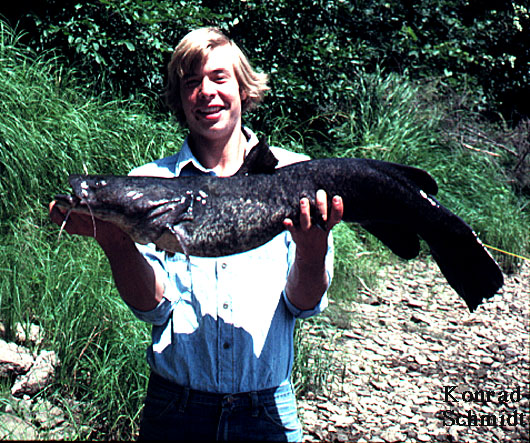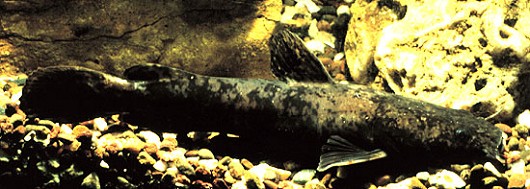Flathead Catfish
-
Scientific NamePylodictis olivaris
-
NativeNo
-
Identification
 Flathead catfish, adult. Caught in the St. Croix River, Washington County, Minnesota, in summer 1976. Photo by Konrad Schmidt, Nongame Fish Biologist, Division of Ecological Services, Minnesota Department of Natural Resources.
Flathead catfish, adult. Caught in the St. Croix River, Washington County, Minnesota, in summer 1976. Photo by Konrad Schmidt, Nongame Fish Biologist, Division of Ecological Services, Minnesota Department of Natural Resources. Flathead catfish, young-of-the-year. Photo by Konrad Schmidt, Nongame Fish Biologist, Division of Ecological Services, Minnesota Department of Natural Resources.
Flathead catfish, young-of-the-year. Photo by Konrad Schmidt, Nongame Fish Biologist, Division of Ecological Services, Minnesota Department of Natural Resources.- Elongate, slender body with an extremely large and flat head and small eyes located towards the top.
- Slightly indented, rounded tail
- Terminal mouth with lower jaw projecting beyond the upper jaw.
- Maxillary barbels are just larger than the head
- Pale blue to olive on the sides and white on the belly
- 14-17 rays in the rounded anal fin
- Large, projecting adipose fin
- Rough spine in pectoral fins
- Black when young, then become olive with brown mottling on the back and sides, and finally become a plain olivaceous yellow-brown
- Yellow to white patch on the upper lobe of the tail
- Males have a distinct genital papilla with an opening at the tip while females have a smaller recessed papilla and a longitudinal slit for the urogenital openings
-
Life History
Flathead Catfish are most commonly found in large, turbid rivers with temperatures between 24°C and 34°C. Adults spend their days alone, resting on the bottom of deep pools or hiding under debris in faster moving areas before moving into the shallow areas to feed at night. Their large flat head makes them well suited for a sit-and-wait hunting strategy, staying very still until prey moves close enough to be engulfed by their large mouth. Small catfish feed mainly on small insect larvae but will shift towards crayfish and fish as they get older. Males mature by 3-5 years of age or when they are about 38 cm long while females mature in 4-6 years or by 46 cm in length. Spawning occurs between May and early July when temperatures exceed 22-24°C. Both male and female work to construct a nest by either creating a new depression in the stream bottom or clearing away a previously submerged hole. After a courtship ritual where the male repeatedly rubs against his mate, the female will lay between 30 and 35 eggs into the nest and then move on to nest with another male elsewhere. In a single season females can lay anywhere between 4,000 and 59,000 eggs. The males will stay with the nest, protecting and fanning the eggs to maximize their oxygen levels until hatching. The young quickly become free swimming but stay together in a tightly packed ball protected by their father until they reach a safe enough size to depart and hide in riffles where rocks and complex debris can be used as cover. When one year old they will be between 11 cm and 12 cm in length and by age 8 they may be as large as 93 cm. It is possible for Flathead Catfish to live to be 19 years and obtain sizes greater than 1.4 m and weights greater than 45 kg, and fish weighing 9-13 kg are not uncommon in the lower Colorado River.
-
Links to Other ResearchN / A

